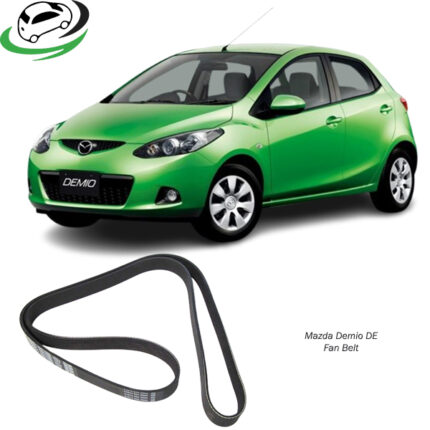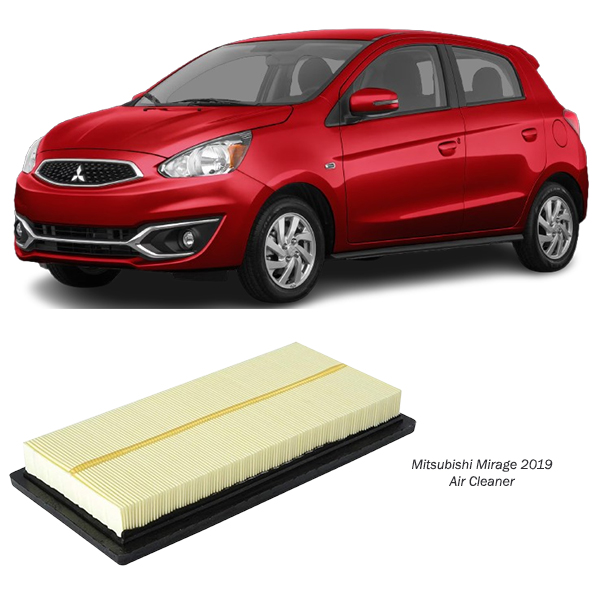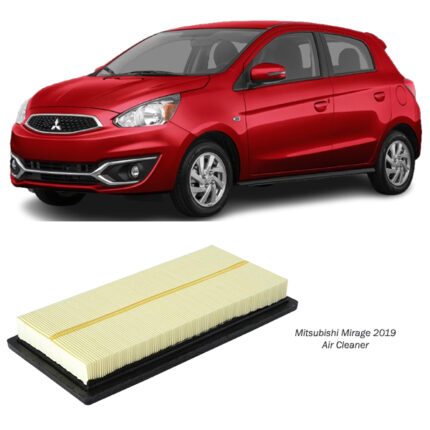Get Mitsubishi Mirage Air Cleaner 1500A399 in Kenya
An air cleaner, commonly referred to as an air filter, is a critical component of a vehicle’s intake system. Its primary purpose is to filter out dust, debris, and other contaminants from the air before it enters the engine. By ensuring a steady flow of clean air, the air cleaner helps maintain engine performance, efficiency, and longevity.
This guide explores the design, types, functions, benefits, maintenance tips, and common issues associated with air cleaners, providing a comprehensive understanding of their importance in automotive systems.
What is an Air Cleaner?
An air cleaner is a replaceable component located in the intake system of an engine. It traps airborne particles such as dirt, pollen, and debris, ensuring that only clean air enters the engine for combustion. This process not only protects the engine but also enhances fuel efficiency and reduces emissions.
Functions of an Air Cleaner
- Filtration of Airborne Contaminants:
- Prevents dust, dirt, and other particles from entering the engine’s combustion chamber, safeguarding sensitive internal components.
- Enhancing Engine Performance:
- Allows optimal air intake, ensuring efficient combustion and consistent power delivery.
- Protecting the Engine:
- Reduces wear and tear on engine components such as pistons, cylinders, and valves by preventing abrasive particles from entering the system.
- Improving Fuel Efficiency:
- Provides the correct air-to-fuel ratio, enabling the engine to burn fuel efficiently.
- Reducing Emissions:
- Helps maintain proper combustion, minimizing the release of harmful pollutants.
Components of an Air Cleaner
- Filter Media:
- The core component responsible for trapping contaminants. Typically made from paper, foam, or cotton.
- Frame:
- Provides structural support and ensures the filter maintains its shape under airflow pressure.
- Seal:
- Ensures a snug fit within the housing, preventing unfiltered air from bypassing the filter.
- Housing:
- Encases the air cleaner and directs filtered air into the engine.
Types of Air Cleaners
- Paper Air Filters:
- Made from pleated paper material.
- Cost-effective and widely used in most vehicles.
- Disposable and require periodic replacement.
- Foam Air Filters:
- Constructed from polyurethane foam.
- Ideal for off-road vehicles due to their ability to handle dusty conditions.
- Washable and reusable.
- Cotton Air Filters:
- Made from layers of cotton gauze.
- High-performance filters allowing greater airflow.
- Washable and reusable, but more expensive.
- Oil-Bath Air Filters:
- Found in older vehicles and heavy machinery.
- Utilize oil to trap contaminants.
- Require regular cleaning and oil replacement.
- Performance Air Filters:
- Designed for high-performance vehicles.
- Offer improved airflow for enhanced engine power.
- Typically washable and reusable.
Importance of Clean Air in the Engine
The combustion process in internal combustion engines relies on a precise mixture of air and fuel. On average, the engine consumes about 14.7 parts air to 1 part fuel. If the air entering the engine is contaminated, it can lead to various problems:
- Reduced Engine Efficiency: Poor combustion due to blocked airflow.
- Increased Wear and Tear: Abrasive particles cause damage to engine components.
- Higher Emissions: Incomplete combustion leads to the release of pollutants.
Signs of a Clogged or Failing Air Cleaner
- Reduced Engine Performance:
- Sluggish acceleration or loss of power indicates restricted airflow.
- Poor Fuel Economy:
- A clogged filter forces the engine to work harder, consuming more fuel.
- Increased Emissions:
- A dirty air filter disrupts the air-to-fuel ratio, resulting in higher emissions.
- Unusual Engine Sounds:
- Whistling or hissing noises from the intake system may signal a blocked filter.
- Dirty Appearance:
- A visibly dirty or clogged air cleaner is an obvious sign it needs replacement.
Maintenance of an Air Cleaner
- Regular Inspections:
- Check the air cleaner every 10,000-15,000 miles or as recommended by the manufacturer.
- Cleaning (for Reusable Filters):
- Wash foam or cotton filters with a suitable cleaning solution and allow them to dry completely before reinstalling.
- Replacement (for Disposable Filters):
- Replace paper filters according to the vehicle’s maintenance schedule or when visibly dirty.
- Ensure Proper Fitment:
- Install the filter correctly to prevent unfiltered air from bypassing it.
- Avoid Over-Oiling (for Oiled Filters):
- Excess oil can damage the mass airflow sensor and reduce performance.
Factors Affecting Air Cleaner Longevity
- Driving Conditions:
- Dusty or sandy environments cause faster clogging.
- Frequency of Use:
- High mileage vehicles require more frequent air cleaner maintenance.
- Quality of Filter:
- Higher quality filters last longer and provide better performance.
Replacing an Air Cleaner: Step-by-Step Guide
- Locate the Air Cleaner Housing:
- Typically found near the front of the engine bay, connected to the intake duct.
- Remove the Housing Cover:
- Undo screws, clips, or latches securing the cover.
- Extract the Old Filter:
- Take out the old filter carefully to avoid spreading debris.
- Clean the Housing:
- Wipe the housing with a clean cloth to remove dirt and debris.
- Install the New Filter:
- Place the new filter into the housing, ensuring it fits snugly.
- Secure the Cover:
- Reattach the housing cover securely to prevent unfiltered air from entering.
Benefits of a Clean Air Cleaner
- Enhanced Engine Performance:
- Ensures consistent power delivery and throttle response.
- Improved Fuel Efficiency:
- Maximizes the air-to-fuel ratio for optimal combustion.
- Prolonged Engine Life:
- Reduces wear on critical engine components.
- Reduced Maintenance Costs:
- Prevents costly repairs by protecting the engine from contaminants.
- Lower Emissions:
- Promotes cleaner combustion, reducing environmental impact.
Common Issues with Air Cleaners
- Bypassing:
- Incorrect installation or damaged seals allow unfiltered air to enter the engine.
- Overloading:
- Excessive dirt and debris clog the filter, restricting airflow.
- Moisture Damage:
- Exposure to water or excessive humidity can degrade the filter material.
- Incompatibility:
- Using the wrong filter type or size for your vehicle can reduce performance.
FAQs
- How often should I replace my air cleaner?
- Typically every 12,000-15,000 miles, but this varies based on driving conditions and filter type.
- Can I drive without an air cleaner?
- No, as unfiltered air can cause severe engine damage.
- Do performance air filters improve horsepower?
- They can enhance airflow, potentially improving engine performance slightly.
- Is cleaning a disposable air filter advisable?
- No, disposable filters are not designed for cleaning and should be replaced.
Conclusion
The air cleaner is a small yet indispensable part of a vehicle’s intake system, ensuring clean air supply for efficient combustion. Regular maintenance and timely replacement of the air cleaner are essential for optimal engine performance, fuel economy, and longevity. Whether you’re a casual driver or a performance enthusiast, investing in a quality air cleaner and adhering to maintenance schedules can save you money and keep your vehicle running smoothly for years to come.
Follow us on Facebook for more parts.




